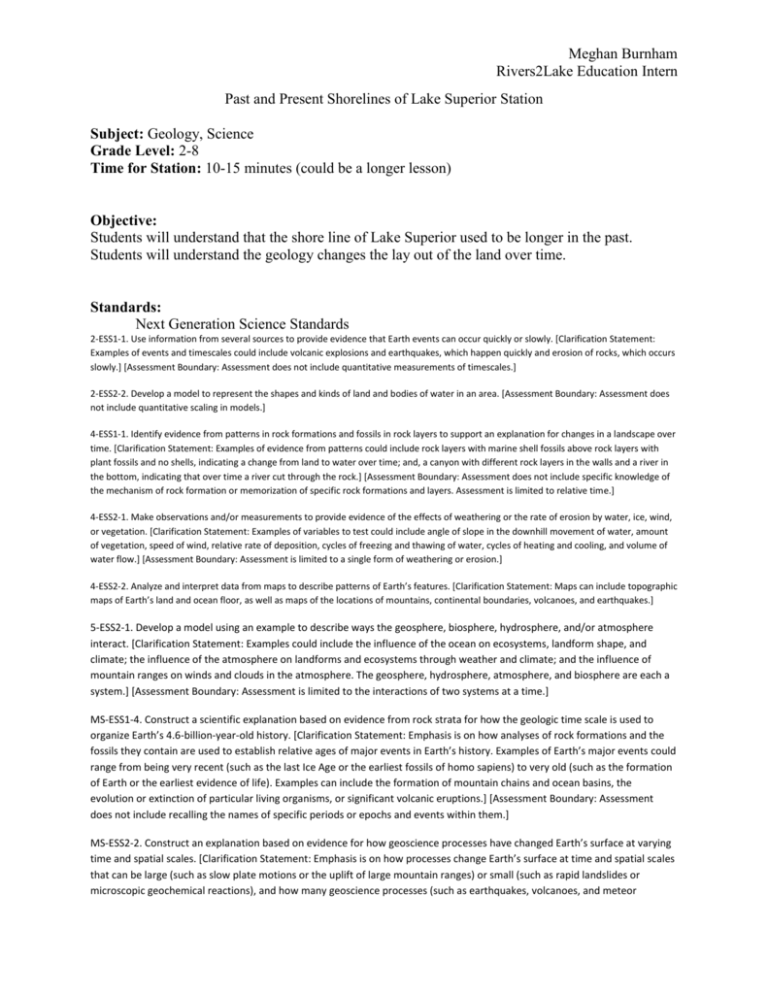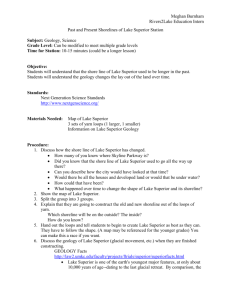Curriculum - Rivers2Lake
advertisement

Meghan Burnham Rivers2Lake Education Intern Past and Present Shorelines of Lake Superior Station Subject: Geology, Science Grade Level: 2-8 Time for Station: 10-15 minutes (could be a longer lesson) Objective: Students will understand that the shore line of Lake Superior used to be longer in the past. Students will understand the geology changes the lay out of the land over time. Standards: Next Generation Science Standards 2-ESS1-1. Use information from several sources to provide evidence that Earth events can occur quickly or slowly. [Clarification Statement: Examples of events and timescales could include volcanic explosions and earthquakes, which happen quickly and erosion of rocks, which occurs slowly.] [Assessment Boundary: Assessment does not include quantitative measurements of timescales.] 2-ESS2-2. Develop a model to represent the shapes and kinds of land and bodies of water in an area. [Assessment Boundary: Assessment does not include quantitative scaling in models.] 4-ESS1-1. Identify evidence from patterns in rock formations and fossils in rock layers to support an explanation for changes in a landscape over time. [Clarification Statement: Examples of evidence from patterns could include rock layers with marine shell fossils above rock layers with plant fossils and no shells, indicating a change from land to water over time; and, a canyon with different rock layers in the walls and a river in the bottom, indicating that over time a river cut through the rock.] [Assessment Boundary: Assessment does not include specific knowledge of the mechanism of rock formation or memorization of specific rock formations and layers. Assessment is limited to relative time.] 4-ESS2-1. Make observations and/or measurements to provide evidence of the effects of weathering or the rate of erosion by water, ice, wind, or vegetation. [Clarification Statement: Examples of variables to test could include angle of slope in the downhill movement of water, amount of vegetation, speed of wind, relative rate of deposition, cycles of freezing and thawing of water, cycles of heating and cooling, and volume of water flow.] [Assessment Boundary: Assessment is limited to a single form of weathering or erosion.] 4-ESS2-2. Analyze and interpret data from maps to describe patterns of Earth’s features. [Clarification Statement: Maps can include topographic maps of Earth’s land and ocean floor, as well as maps of the locations of mountains, continental boundaries, volcanoes, and earthquakes.] 5-ESS2-1. Develop a model using an example to describe ways the geosphere, biosphere, hydrosphere, and/or atmosphere interact. [Clarification Statement: Examples could include the influence of the ocean on ecosystems, landform shape, and climate; the influence of the atmosphere on landforms and ecosystems through weather and climate; and the influence of mountain ranges on winds and clouds in the atmosphere. The geosphere, hydrosphere, atmosphere, and biosphere are each a system.] [Assessment Boundary: Assessment is limited to the interactions of two systems at a time.] MS-ESS1-4. Construct a scientific explanation based on evidence from rock strata for how the geologic time scale is used to organize Earth’s 4.6-billion-year-old history. [Clarification Statement: Emphasis is on how analyses of rock formations and the fossils they contain are used to establish relative ages of major events in Earth’s history. Examples of Earth’s major events could range from being very recent (such as the last Ice Age or the earliest fossils of homo sapiens) to very old (such as the formation of Earth or the earliest evidence of life). Examples can include the formation of mountain chains and ocean basins, the evolution or extinction of particular living organisms, or significant volcanic eruptions.] [Assessment Boundary: Assessment does not include recalling the names of specific periods or epochs and events within them.] MS-ESS2-2. Construct an explanation based on evidence for how geoscience processes have changed Earth’s surface at varying time and spatial scales. [Clarification Statement: Emphasis is on how processes change Earth’s surface at time and spatial scales that can be large (such as slow plate motions or the uplift of large mountain ranges) or small (such as rapid landslides or microscopic geochemical reactions), and how many geoscience processes (such as earthquakes, volcanoes, and meteor Meghan Burnham Rivers2Lake Education Intern impacts) usually behave gradually but are punctuated by catastrophic events. Examples of geoscience processes include surface weathering and deposition by the movements of water, ice, and wind. Emphasis is on geoscience processes that shape local geographic features, where appropriate.] Materials Needed: Map of Lake Superior 3 sets of yarn loops (1 larger, 1 smaller) Information on Lake Superior Geology Procedure: 1. Discuss how the shore line of Lake Superior has changed. How many of you know where Skyline Parkway is? Did you know that the shore line of Lake Superior used to go all the way up there? Can you describe how the city would have looked at that time? Would there be all the houses and developed land or would that be under water? How could that have been? What happened over time to change the shape of Lake Superior and its shoreline? 2. Show the map of Lake Superior. 3. Split the group into 3 groups. 4. Explain that they are going to construct the old and new shoreline out of the loops of yarn. Which shoreline will be on the outside? The inside? How do you know? 5. Hand out the loops and tell students to begin to create Lake Superior as best as they can. They have to follow the shape. (A map may be referenced for the younger grades) You can make this a race if you want. 6. Discuss the geology of Lake Superior (glacial movement, etc.) when they are finished constructing. GEOLOGY Facts http://law2.umkc.edu/faculty/projects/ftrials/superior/superiorfacts.html Lake Superior is one of the earth's youngest major features, at only about 10,000 years of age--dating to the last glacial retreat. By comparison, the earth's second largest lake (by surface area, and largest by volume), Lake Baikal in Russia, is 25 million years old. Lake Superior has been at its modern elevation for only about 2,000 years. Lake Superior has its origins in the North American Mid-Continent Rift of 1.1 to 1.2 billion years ago, which produced a huge plume of hot mantle where the present lake sits. The crust tore apart, leaving an arc-shaped scar stretching from Kansas through Minnesota, then down to Michigan. Meghan Burnham Rivers2Lake Education Intern Within its borders, Lake Superior has both the thickest, and nearly the thinnest, crust found anywhere in North America. Some of the world's oldest rocks, about 2.7 billion years of age, can be found on the Ontario shore of Lake Superior. Lake Superior rests mostly on Precambrian rock at the southern edge of the Canadian Shield, the largest exposure of such bedrock on the planet. Closing: Review information presented. Ask for questions. Rotate stations. Evaluation: 1. Informal evaluation can be conducted through discussion. 2. At the end, students could write one thing they learned/thought was interesting as a formative assessment. **Evaluation can be modified to fit the needs of the lesson.










